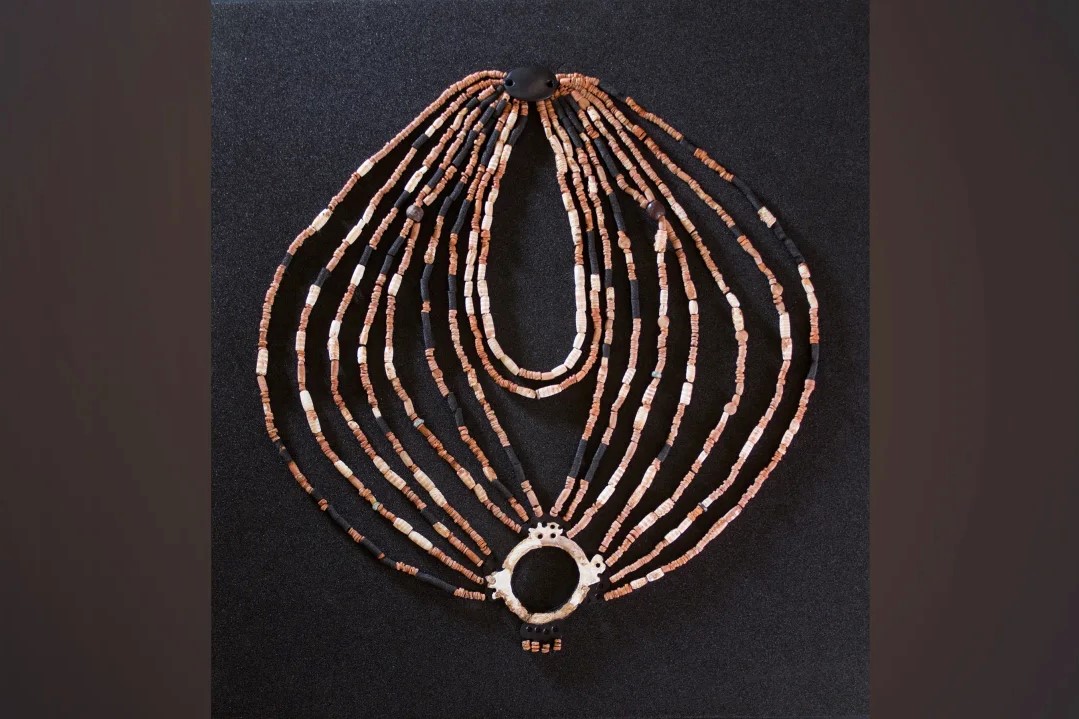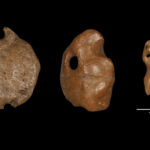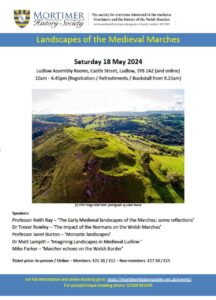Re-assembled neolithic child’s necklace found in Jordan
These news items are taken from a variety of sources from UK and beyond, covering many topics which you may have missed.
No attempt has been made to verify any of the information in these sources and no claim to the list being comprehensive is made. Note that CBA Wales has no control over the content of external sites though care has been taken to select from reputable websites. Click on source to view full article.
Fascinating Stone Age discoveries may rewrite Scotland’s history Date: 30th July 2023 Source: Herald Scotland
Professor Kate Britton is at the forefront of redefining Scotland’s ancient history. Previously, it was believed that humans did not inhabit Scotland before the Mesolithic period, roughly 10,000 years ago. However, recent discoveries of Stone Age tools from the older Palaeolithic period, dating back around 14,000 years, have challenged this notion. These findings suggest that humans arrived in Scotland thousands of years earlier than previously thought. Britton has secured £1.7 million in funding to further investigate the lives of these early inhabitants. The research aims to revolutionize our understanding of the Stone Age in Scotland, shedding light on the animals, plants, and landscapes of that era. The research aims to provide a comprehensive understanding of the Stone Age in Scotland, which has been largely overlooked until now.
Immaculately-preserved Iron Age skeleton dating back 2,500 years uncovered in Alderney Date: 9 August 2023 Source: ITV News
A 2,500-year-old skeleton, affectionately named ‘Bob’, has been discovered in Alderney during an archaeological dig. Estimated to have died in the 5th or 6th century at around 19-20 years of age, ‘Bob’ is one of the most immaculately-preserved prehistoric skeletons found in Alderney. The discovery suggests the presence of a large cemetery site in the area. Interestingly, unlike other Iron Age burials, no grave goods were found with ‘Bob’, leading to speculations about his societal status.
Archaeologists are in a desperate battle to save a historic Pictish hillfort from the Scottish government’s ‘carbon-offsetting’ woodland scheme Date: Not specified Source: MSN
A significant Pictish hillfort in Aberdeenshire is at risk due to a ‘carbon-offsetting’ woodland scheme. Experts have expressed concerns that the Scottish Government’s plan to cover 21% of the country in woodland within the next decade could damage this archaeological site of “international significance.” Treeline Forestry Limited intends to plant trees on 500 acres at Mains of Rhynie, an area that was a prominent Pictish center from the 4th to 6th centuries. Archaeologist Professor Gordon Noble compared the potential damage to afforestation schemes near Stonehenge. Extensive excavations since 2011 have revealed an expansive Pictish cemetery in the vicinity. The proposal has sparked local community outrage, with many viewing it as an exploitative business venture.
‘First English slave fort in Africa’ uncovered on Ghana’s coast Date: 1 August: Source: BBC News
Archaeologists believe they have located the first English slave fort in Africa, Fort Kormantine, which predates the Dutch-built Fort Amsterdam in Ghana. This fort, established in 1631, initially served as a trading post for gold and ivory. However, by 1663, it became a starting point for the English slave trade under King Charles II’s Royal African Company. The fort’s exact location remained speculative until recent excavations revealed 17th-century artifacts, including a gunflint, tobacco pipes, and a goat’s jawbone. These findings suggest the English presence before the Dutch fort and provide insights into the early stages of the transatlantic slave trade.
The South Downs explored from above: a landscape of rich archaeology revealed Date: 9 August 2023 Source: Yahoo Sports
The South Downs, a range of chalk hills in southeast England, has been explored from an aerial perspective, revealing a rich tapestry of archaeological wonders. This bird’s-eye view has unveiled numerous ancient landmarks, including burial mounds, hill forts, and historical farming landscapes. These findings provide a deeper understanding of the region’s past, showcasing the intricate relationship between its inhabitants and the environment over millennia.
Ornate necklace found in an ancient grave site of a child and reassembled Date: August 4, 2023 Source: CNN
An ornate necklace, believed to be from the Neolithic era, has been discovered in an ancient Jordanian gravesite of a child. The intricate piece was meticulously reassembled, showcasing the craftsmanship and cultural significance of jewelry from that period. The find offers insights into the societal and ritualistic practices of ancient communities, emphasizing the importance they placed on adornments even for their young.
Scientific discovery casts doubt on our understanding of human evolution Date: 9 August 2023 Source: The Independent
Scientists are reevaluating our understanding of human evolution following the discovery of evidence suggesting that a group of ‘ape-men’, named Homo naledi, may have developed a complex human-like culture thousands of years before Homo sapiens. Found in the Rising Star Cave in South Africa, the evidence indicates that these beings had beliefs about an afterlife, buried their dead, and even created rudimentary art. Despite having brains a third the size of modern humans, their behaviour and practices challenge long-held beliefs about cognitive evolution.
Arrowhead made from meteorite 3,000 years ago found near lake in Europe Date: August 8, 2023 Source: CNN
A Bronze Age arrowhead, dating back to between 900 and 800 BC, has been discovered in Mörigen on Lake Biel, Switzerland. Remarkably, this 39-millimeter-long artifact was crafted from iron derived from a meteorite that had landed in Estonia. This discovery suggests that meteoritic iron was traded across Europe by 800 BC or even earlier, a significant revelation given the rarity of such early use of meteoritic iron. While humans hadn’t begun smelting iron from oxide ores at the time, they could find metallic iron in meteorite impact fields. This arrowhead’s discovery adds Mörigen as a third site in Europe with artifacts made of meteoritic iron.
Ancient 2,000-year-old Roman shipwreck found off coast of Italy Date: Not specified: Source: BBC News
The wreckage of a 2,000-year-old Roman cargo ship has been discovered off the port of Civitavecchia, Italy. Dating from the 1st or 2nd Century BC, the ship was found laden with hundreds of amphorae, mostly intact. The ship, estimated to be over 20m long, was found 160m below sea level. The Carabinieri police’s art squad, responsible for protecting Italy’s cultural heritage, made the discovery using a remotely operated robot. The find bears witness to ancient maritime trading routes, and the amphorae may have been used to transport goods like oil, wine, or fish sauce.
Emperor Nero’s lost theatre found under site of hotel in Rome Date: 27 Jul 2023: Source: The Guardian
The ruins of Nero’s Theatre, a significant structure mentioned in ancient Roman texts but never previously located, have been unearthed beneath the garden of an upcoming Four Seasons hotel near the Vatican. The excavation began in 2020 under the Palazzo della Rovere’s garden. This discovery provides a unique glimpse into Roman history, spanning from the empire to the 15th century. Notable finds include 10th-century colored glass goblets and pottery pieces, shedding light on a lesser-known period in Rome. The site’s chief archaeologist, Marzia Di Mento, highlighted the discovery of marble columns and gold leaf-decorated plaster, confirming the theatre’s location mentioned in Pliny the Elder’s texts.
300,000-year-old skull found in China unlike any early human seen before Date: 10/08/2023: Source: CNN
An ancient skull mandible (lower jaw) discovered in the Hualongdong region of eastern China from around 300,000 years ago might represent a new branch of the human family tree. Unearthed in 2015 by an international research team, this mandible, designated HLD 6, does not fit into existing human fossil classifications. While it bears resemblance to the Homo sapiens jaw, it also shares features with the Denisovans, an evolutionary branch from Homo erectus. HLD 6 has a mosaic of features, both primitive and resembling modern humans. The specimen is believed to have belonged to a 12-13-year-old. Given its unique features, it suggests that characteristics of modern humans might have been present earlier than previously thought in east Asia. More research is needed to determine HLD 6’s exact position in our evolutionary history.









